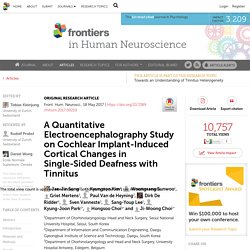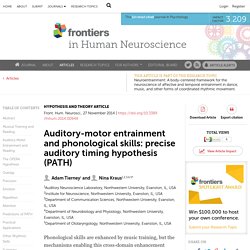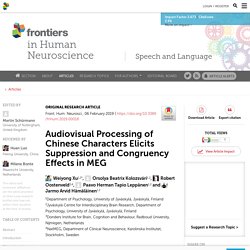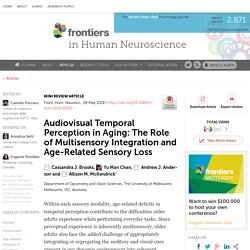

Age, dyslexia subtype and comorbidity modulate rapid auditory processing in developmental dyslexia. Introduction Developmental Dyslexia (DD) is defined as a specific disability in learning to read adequately despite at least normal intelligence, adequate instruction and socio-cultural opportunities, and the absence of sensory defects in vision and hearing (American Psychiatric Association, 1994).

The prevailing views concerning the etiology of DD point to a deficit in encoding, representing and processing speech sounds (Snowling, 2001; Ramus et al., 2003; Ramus and Szenkovits, 2008). However, the question whether these difficulties reveal the core deficit of dyslexia or whether they are manifestations of a more general and basic auditory deficit is controversial. According to Tallal's (1980) hypothesis, children with DD would be impaired in their ability to perceive auditory stimuli that have short duration and occur in rapid succession. A second controversy concerns the selectivity of the auditory processing deficit i.e., its being restricted to brief and rapidly presented stimuli. Altered connectivity of the dorsal and ventral visual regions in dyslexic children: a resting-state fMRI study.
1State Key Laboratory of Cognitive Neuroscience and Learning and IDG/McGovern Institute for Brain Research, Beijing Normal University, Beijing, China2Center for Collaboration and Innovation in Brain and Learning Sciences, Beijing Normal University, Beijing, China3Beijing Key Lab of Learning and Cognition, Department of Psychology, Capital Normal University, Beijing, China While there is emerging evidence from behavioral studies that visual attention skills are impaired in dyslexia, the corresponding neural mechanism (i.e., deficits in the dorsal visual region) needs further investigation.

We used resting-state fMRI to explore the functional connectivity (FC) patterns of the left intraparietal sulcus (IPS) and the visual word form area (VWFA) in dyslexic children (N = 21, age mean = 12) and age-matched controls (N = 26, age mean = 12). Keywords: dyslexia, visual attention deficit, dorsal visual region, resting-state Edited by: A multisensory perspective of working memory. Department of Experimental Psychology, Ghent University, Ghent, Belgium Although our sensory experience is mostly multisensory in nature, research on working memory representations has focused mainly on examining the senses in isolation.

Results from the multisensory processing literature make it clear that the senses interact on a more intimate manner than previously assumed. These interactions raise questions regarding the manner in which multisensory information is maintained in working memory. We discuss the current status of research on multisensory processing and the implications of these findings on our theoretical understanding of working memory. To do so, we focus on reviewing working memory research conducted from a multisensory perspective, and discuss the relation between working memory, attention, and multisensory processing in the context of the predictive coding framework. A Quantitative Electroencephalography Study on Cochlear Implant-Induced Cortical Changes in Single-Sided Deafness with Tinnitus.
Introduction Tinnitus, the conscious perception of sound in the absence of a corresponding external acoustic stimulus (Baguley et al., 2013), afflicts 10–15% of the adult population and interferes severely with the quality of life of 5–26% of the affected population (Heller, 2003; Krog et al., 2010).

The development of tinnitus is frequently deemed to be a neuroplastic response to sensory deprivation (Eggermont and Roberts, 2004; Song et al., 2012). A review on functional and structural brain connectivity in numerical cognition. In the history of neurology, attempts to explain normal and impaired cognitive function following brain damage have alternated between two extreme perspectives; specifically, views based on localization of function and views based on functional connectivity.

The localizationist view ascribes specific cognitive functions to gray matter (GM) brain areas with cognitive impairments attributed to lesions of these specific areas. Attentional and non-attentional systems in the maintenance of verbal information in working memory: the executive and phonological loops. 1Laboratory of Cognitive Development, Fribourg Center for Cognition, Département de Psychologie, Université de Fribourg, Fribourg, Switzerland2Developmental Cognitive Psychology, Faculté de Psychologie et des Sciences l’Education, Université de Genève, Genève, Switzerland Working memory is the structure devoted to the maintenance of information at short term during concurrent processing activities.

In this respect, the question regarding the nature of the mechanisms and systems fulfilling this maintenance function is of particular importance and has received various responses in the recent past. In the time-based resource-sharing (TBRS) model, we suggest that only two systems sustain the maintenance of information at the short term, counteracting the deleterious effect of temporal decay and interference.
Auditory-motor entrainment and phonological skills: precise auditory timing hypothesis (PATH) Musical Training and Reading There is growing interest in the idea that music training can enhance language skills.

This music-to-language transfer has been observed for a number of communication skills, including speech-in-noise perception (Parbery-Clark et al., 2009; Strait et al., 2012; Zendel and Alain, 2012) and verbal memory (Chan et al., 1998; Tierney et al., 2008; Parbery-Clark et al., 2009, 2011; Strait et al., 2010), but the skill that has been most extensively investigated is the ability to read. Auditory cortical deactivation during speech production and following speech perception: an EEG investigation of the temporal dynamics of the auditory alpha rhythm.
1Department of Audiology and Speech Pathology, University of Tennessee Health Science Center, Knoxville, TN, USA2Department of Communication Disorders, University of Arkansas, Fayetteville, AR, USA Sensorimotor integration (SMI) across the dorsal stream enables online monitoring of speech.

Jenson et al. (2014) used independent component analysis (ICA) and event related spectral perturbation (ERSP) analysis of electroencephalography (EEG) data to describe anterior sensorimotor (e.g., premotor cortex, PMC) activity during speech perception and production. The purpose of the current study was to identify and temporally map neural activity from posterior (i.e., auditory) regions of the dorsal stream in the same tasks. Audiovisual Processing of Chinese Characters Elicits Suppression and Congruency Effects in MEG. Introduction Learning to read involves the integration of multisensory information (primarily from the auditory and visual modalities) and combining it with meaning.

Multisensory integration, defined as modulation of brain responses by signals from multiple modalities, has been shown to be a dynamic and context-dependent process (van Atteveldt et al., 2014; Murray et al., 2016a). In natural audiovisual speech perception, it has been shown that complementary or correlated visual speech information could affect the auditory processing of speech by activating the perisylvian auditory speech regions through the ventral and dorsal visual streams (Campanella and Belin, 2007; Campbell, 2008; Bernstein and Liebenthal, 2014).
Multisensory integration is also found within the visual cortices during early and late post-stimulus stages and could directly impact perception (Murray et al., 2016b; Kayser et al., 2017). Audiovisual Temporal Perception in Aging: The Role of Multisensory Integration and Age-Related Sensory Loss. Introduction The normal aging process degrades both auditory and visual temporal perception, contributing to the difficulties older adults encounter with everyday tasks.

Awareness of Rhythm Patterns in Speech and Music in Children with Specific Language Impairments. Brain plasticity-based therapeutics. Background In the evolution of treatments of neurological and psychiatric impairments and illness, mainstream medical science has followed two broad paths. One originated with the early Twentieth Century discovery of pharmaceutical agents demonstrated to have powerful, distorting impacts on human neurology (Perrine, 1996; López-Muñoz and Alamo, 2009). Especially from about the middle of the Twentieth Century onward, drug-based medicine has been increasingly strongly supported by technically-sophisticated fundamental neuroscience, which has struggled mightily to describe and define neurological processes and diseases in specific chemical terms, on the path to their chemical manipulation for medical advantage.
Into the present era, legions of medical professionals predominantly deploy one or the other of these two classes of therapeutic tools to address, in very different ways, the hundreds of neurological and psychiatric disorders that fall within their clinical purview. Brain Responses to Letters and Speech Sounds and Their Correlations With Cognitive Skills Related to Reading in Children. Introduction Letter-speech sound (LSS) integration is a key step in learning to read for alphabetic languages. The development and reorganization of early readers’ language circuits for supporting automatized LSS integration and how such integration is related to the development of fluent reading are crucial questions from both theoretical and practical point of view (Shankweiler et al., 2008; Dehaene et al., 2015).
Research has shown that in early readers, the print-speech convergence (as measured by coactivation in fMRI) in the left reading network (inferior frontal gyrus, inferior parietal cortex, and fusiform gyrus) is a significant predictor of reading achievement measured 2 years later (Preston et al., 2016). In another study using four contrasting languages to find common indices of successful literacy acquisition, highly similar neural organization for print-speech convergence was observed between the languages. Cochlear implantation (CI) for prelingual deafness: the relevance of studies of brain organization and the role of first language acquisition in considering outcome success.
1Deafness Cognition and Language Research Centre, University College London, London, UK2Institute of Cognitive Neuroscience, University College London, London, UK Cochlear implantation (CI) for profound congenital hearing impairment, while often successful in restoring hearing to the deaf child, does not always result in effective speech processing. Exposure to non-auditory signals during the pre-implantation period is widely held to be responsible for such failures. Here, we question the inference that such exposure irreparably distorts the function of auditory cortex, negatively impacting the efficacy of CI. Cortical Alpha Oscillations Predict Speech Intelligibility.
Introduction Hearing in humans is normally quantified using pure tone audiometry, which measures absolute sensitivity across a wide range of pure tone frequencies centered on those thought most useful for speech perception (Moore, 2013). However, the resulting audiogram does not provide a complete picture of listening abilities encountered in everyday environments. Crossmodal deficit in dyslexic children: practice affects the neural timing of letter-speech sound integration. Introduction Although most children learn to read fluently, between 5 and 10% of children are diagnosed with developmental dyslexia exhibiting deficient reading skills despite normal cognitive abilities and schooling opportunities (Lyon et al., 2003; Blomert, 2005; Snowling, 2013).
The formation of letter-speech sound pairs, an important first step in obtaining reading expertise in alphabetic orthographies, forms an immediate obstacle for beginner readers with dyslexia (Share, 1995; Ehri, 2005; Wimmer and Schurz, 2010; Blomert, 2011). Consequently, many dyslexia interventions include modules focused on teaching letter-speech sound correspondences (Bus and Van Ijzendoorn, 1999; Tijms and Hoeks, 2005; Aravena et al., 2013) next to dealing with impaired phonological processing (Snowling, 1998; Ramus and Szenkovits, 2008).
Figure 1. Design of the auditory and the audiovisual conditions. Don't words come easy? A psychophysical exploration of word superiority. Effects of Training on Lateralization for Simulations of Cochlear Implants and Single-Sided Deafness. Introduction While cochlear implantation has been shown to improve sound source localization in patients with single-sided deafness (SSD), there is great variability in localization performance among SSD cochlear implant (CI) patients (Vermeire and Van de Heyning, 2009; Arndt et al., 2011; Firszt et al., 2012; Kamal et al., 2012; Távora-Vieira et al., 2013; Tokita et al., 2014; van Zon et al., 2015; Dorman et al., 2016). Localization performance for SSD CI patients remains poorer than that of normal-hearing (NH) listeners and is comparable to that of bilateral CI patients (Dorman et al., 2016).
The poorer performance and variability may reflect difficulties in combining temporal fine structure (TFS) cues from acoustic hearing with relatively coarse spectro-temporal envelope cues from electric hearing. Emotional language processing in autism spectrum disorders: a systematic review. Introduction. ERPs Reveal the Time-Course of Aberrant Visual-Phonological Binding in Developmental Dyslexia. Introduction. Evidence from neglect dyslexia for morphological decomposition at the early stages of orthographic-visual analysis.
Executive functions in developmental dyslexia. Introduction. Face processing improvements in prosopagnosia: successes and failures over the last 50 years. Functionally distinct contributions of the anterior and posterior putamen during sublexical and lexical reading. Functional neuroanatomy of developmental dyslexia: the role of orthographic depth. Greater Repertoire and Temporal Variability of Cross-Frequency Coupling (CFC) Modes in Resting-State Neuromagnetic Recordings among Children with Reading Difficulties. Introduction The neurophysiological basis and functional significance of spontaneous brain activity remains disputable among neuroscientists, ever since the initial demonstration of focally reduced activity associated with increased cognitive demands (Pinneo, 1966).
Guidelines and quality measures for the diagnosis of optic ataxia. Immaturity of Visual Fixations in Dyslexic Children. Induction of neuroplasticity and recovery in post-stroke aphasia by non-invasive brain stimulation. Intensive Treatment with Ultrasound Visual Feedback for Speech Sound Errors in Childhood Apraxia. Investigating the role of visual and auditory search in reading and developmental dyslexia. Is the Sensorimotor Cortex Relevant for Speech Perception and Understanding? An Integrative Review. Letter and Speech Sound Association in Emerging Readers With Familial Risk of Dyslexia. Link between cognitive neuroscience and education: the case of clinical assessment of developmental dyscalculia.
Longitudinal maturation of auditory cortical function during adolescence. Magnocellular-dorsal pathway and sub-lexical route in developmental dyslexia. Mathematical difficulties as decoupling of expectation and developmental trajectories. Medial Efferent Mechanisms in Children with Auditory Processing Disorders. Misophonia: physiological investigations and case descriptions. Musicians’ Online Performance during Auditory and Visual Statistical Learning Tasks. Neural bases of accented speech perception. Neural entrainment to rhythmic speech in children with developmental dyslexia. Neurobiological, Cognitive, and Emotional Mechanisms in Melodic Intonation Therapy. Neurobiological foundations of multisensory integration in people with autism spectrum disorders: the role of the medial prefrontal cortex.
Neuromagnetic Vistas into Typical and Atypical Development of Frontal Lobe Functions. On development of functional brain connectivity in the young brain. Oscillatory “temporal sampling” and developmental dyslexia: toward an over-arching theoretical framework. Prefrontal cortex and executive function in young children: a review of NIRS studies. Procedural skills and neurobehavioral freedom. Physiologic discrimination of stop consonants relates to phonological skills in pre-readers: a biomarker for subsequent reading ability?† Rhythm perception and production predict reading abilities in developmental dyslexia. Reading into neuronal oscillations in the visual system: implications for developmental dyslexia. Reading the dyslexic brain: multiple dysfunctional routes revealed by a new meta-analysis of PET and fMRI activation studies. Spatial and temporal attention in developmental dyslexia. Symbiosis of executive and selective attention in working memory.
The Beat to Read: A Cross-Lingual Link between Rhythmic Regularity Perception and Reading Skill. The Co-Occurrence of Autism and Attention Deficit Hyperactivity Disorder in Children – What Do We Know? The effects of music listening on pain and stress in the daily life of patients with fibromyalgia syndrome. The Functional Neuroanatomy of Letter-Speech Sound Integration and Its Relation to Brain Abnormalities in Developmental Dyslexia. The Functional Role of Neural Oscillations in Non-Verbal Emotional Communication. The intergenerational multiple deficit model and the case of dyslexia. The Oscillopathic Nature of Language Deficits in Autism: From Genes to Language Evolution. The rehabilitation of face recognition impairments: a critical review and future directions.
The relationship of phonological ability, speech perception, and auditory perception in adults with dyslexia. The Role of Rhythm in Speech and Language Rehabilitation: The SEP Hypothesis. The trajectory of gray matter development in Broca’s area is abnormal in people who stutter. The VWFA: it's not just for words anymore. Training on Movement Figure-Ground Discrimination Remediates Low-Level Visual Timing Deficits in the Dorsal Stream, Improving High-Level Cognitive Functioning, Including Attention, Reading Fluency, and Working Memory. Transcranial direct current stimulation modulates efficiency of reading processes.
Visual, Auditory, and Cross Modal Sensory Processing in Adults with Autism: An EEG Power and BOLD fMRI Investigation. Visual Illusions: An Interesting Tool to Investigate Developmental Dyslexia and Autism Spectrum Disorder. Visual processing of multiple elements in the dyslexic brain: evidence for a superior parietal dysfunction. Visual word learning in adults with dyslexia.